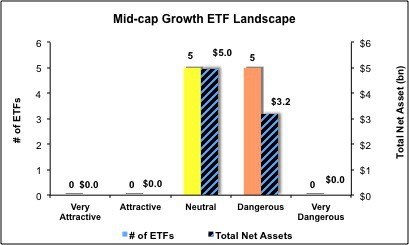The mid-cap growth style ranks seventh out of the twelve fund styles as detailed in my style roadmap. It gets my Neutral rating, which is based on aggregation of ratings of 10 ETFs and 367 mutual funds in the mid-cap growth style as of July 18, 2012. Reports on the best & worst ETFs and mutual funds in every sector and style are here.
Figure 1 ranks from best to worst the eight mid-cap growth ETFs that meet our liquidity standards and Figure 2 shows the five best and worst-rated mid-cap growth mutual funds. Not all mid-cap growth style ETFs and mutual funds are created the same. The number of holdings varies widely (from 17 to 458), which creates drastically different investment implications and ratings. The best ETFs and mutual funds allocate more value to Attractive-or-better-rated stocks than the worst, which allocate too much value to Neutral-or-worse-rated stocks.
To identify the best and avoid the worst ETFs and mutual funds within the mid-cap growth style, investors need a predictive rating based on (1) stocks ratings of the holdings and (2) the all-in expenses of each ETF and mutual fund. Investors need not rely on backward-looking ratings. My fund rating methodology is detailed here.
Investors should not buy any mid-cap growth ETFs or mutual funds because none get an Attractive-or-better rating. If you must have exposure to this style, you should buy a basket of Attractive-or-better rated stocks and avoid paying undeserved fund fees. Active management has a long history of not paying off.
See ratings and reports on all ETFs and mutual funds in this style on my free mutual fund and ETF screener.
Figure 1: ETFs with the Best & Worst Ratings – Top 5 (where available)

Sources: New Constructs, LLC and company filings
PowerShares RAFI Fundamental Pur Mid Growth Portfolio (PXMG) and ProShares Ultra Russell MidCap Growth (UKW) are excluded from Figure 1 because their total net assets (TNA) are below $100 million and do not meet our liquidity standards.
Figure 2: Mutual Funds with the Best & Worst Ratings – Top 5

Sources: New Constructs, LLC and company filings
Eight mutual funds are excluded from Figure 2 because their total net assets (TNA) are below $100 million and do not meet our liquidity standards.
Vanguard Mid-Cap Growth ETF (VOT) is my top-rated mid-cap growth ETF and Nicholas II, Inc: Class I Shares (NCTWX) is my top-rated mid-cap growth mutual fund. Both earn my Neutral rating.
First Trust Mid Cap Growth AlphaDEX Fund (FNY) earns my Dangerous rating and is my worst-rated mid-cap growth ETF. Mutual Fund Series Trust: Eventide Gilead Fund (ETAGX) earns my Very Dangerous rating and is my worst-rated mid-cap growth mutual fund.
Figure 3 shows that 367 out of the 1463 stocks (29% of the total net assets) held by mid-cap growth ETFs and mutual funds get an Attractive-or-better rating. This low allocation to investment worthy stocks is the reason no mid-cap growth ETFs or mutual funds are worth buying. None of the 367 mutual funds are justifying their total annual costs.
The takeaways are: mutual fund managers allocate too much capital to low-quality stocks and mid-cap growth ETFs offer exposure to poor quality stocks.
Figure 3: Mid-cap Growth Style Landscape For ETFs, Mutual Funds & Stocks
As detailed in “Cheap Funds Dupe Investors”, the fund industry offers many cheap funds but very few funds with high-quality stocks, or with what I call good portfolio management.
Investors should not buy any mid-cap growth ETFs and mutual funds. None of mid-cap growth ETFs or mutual funds allocate enough value to Attractive-or-better-rated stocks to earn an Attractive-or-better rating. Investors seeking exposure to mid-cap growth stocks are better off buying Attractive-or-better-rated mid-cap growth stocks. Review my free stock screener for individual stock investments.
Altera Corporation (ALTR) is one of my favorite stocks held by mid-cap growth ETFs and mutual funds and earns my Very Attractive rating. ALTR is a model for capital efficiency with a return on invested capital (ROIC) of 251% for fiscal year end 2011, which places the company in the 99th percentile of the Russell 3000. A high ROIC makes ALTR a good company, and it is also a great stock. ALTR”s current stock price (~$30.69) implies that profits (NOPAT) will permanently decrease by 20%. Strong economics coupled with low expectations make ALTR an excellent long candidate.
Digital Realty Trust, Inc. (DLR) is one of my least favorite stocks held by mid-cap growth ETFs and mutual funds and earns my Very Dangerous rating. DLR has misleading earnings, which means that its reported earnings are positive and rising while its economic earnings are negative and declining. Couple that with the fact that the company has failed to generate a ROIC in excess of its weighted average cost of capital (WACC) since 2004, and its clear that DLR does not have a profitable business model. In spite of poor past performance, the market believes DLR will turn things around. To justify its current stock price (~$80.31) the company must increase profits by 10.2% compounded annually for 36 years. Poor past performance and a high performance hurdle offer investors a poor risk/reward tradeoff.
Figures 4 and 5 show the rating landscape of all mid-cap growth ETFs and mutual funds.
Our style roadmap report ranks all styles and highlights those that offer the best investments.
Figure 4: Separating the Best ETFs From the Worst Funds
Figure 5: Separating the Best Mutual Funds From the Worst Funds
Review my full list of ratings and rankings along with free reports on all 10 ETFs and 367 mutual funds in the mid-cap growth style.
Disclosure: I receive no compensation to write about any specific stock, sector, style or theme.


